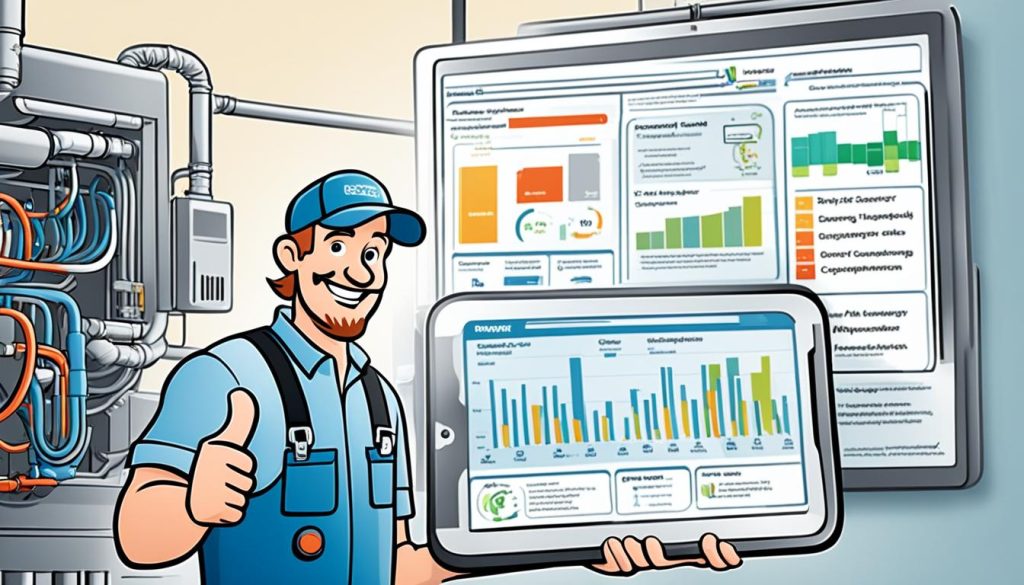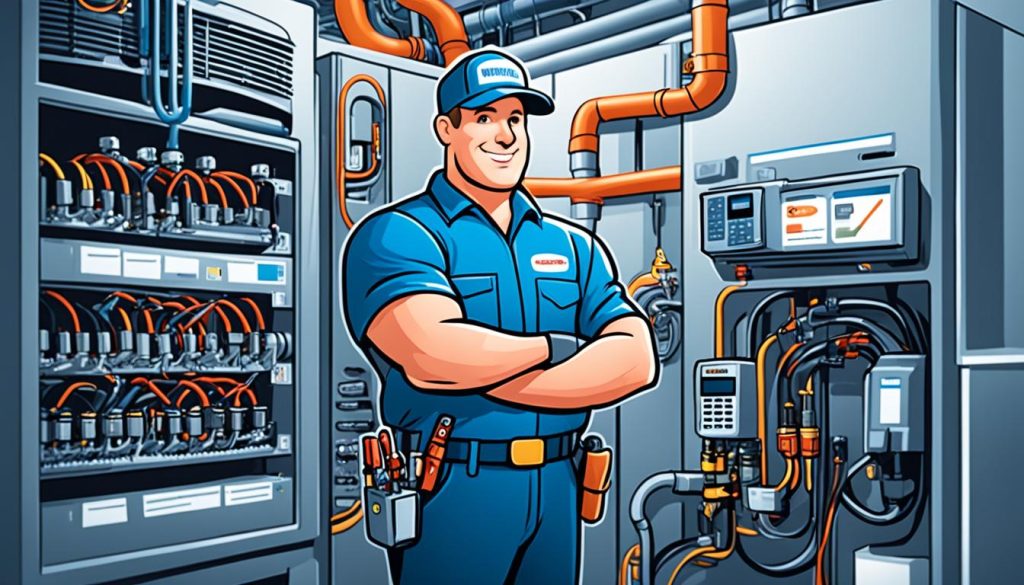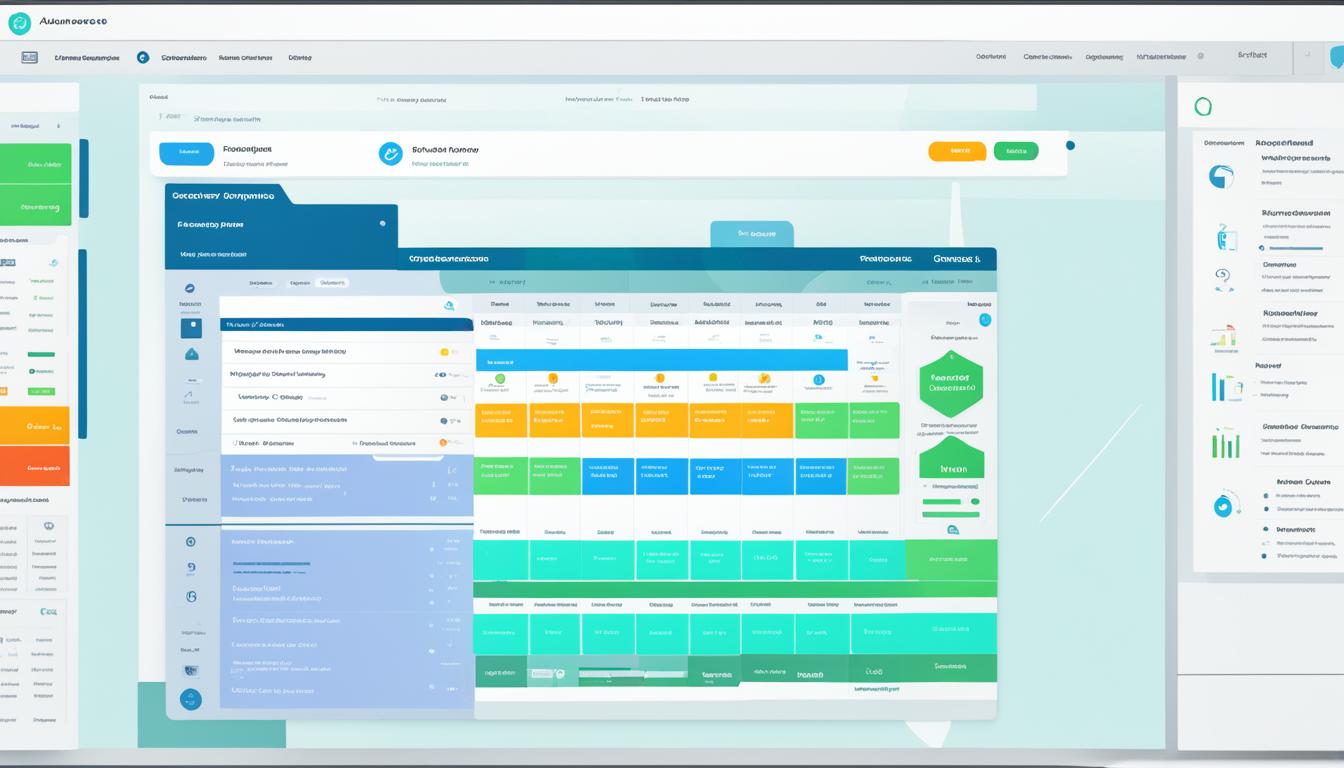Creating effective HVAC preventive maintenance programs is easy with the right software. These tools help streamline your maintenance tasks for heating, ventilation, and air conditioning systems. They let you track, schedule, and manage maintenance tasks efficiently.
HVAC preventive maintenance software has many features to boost efficiency and cut costs. You can set up automated schedules, check equipment performance, and get detailed reports. This software helps you spot issues early, reducing emergency calls and making your HVAC systems last longer.
With the right software, you can make maintenance plans that fit your HVAC equipment. This ensures each part gets the right care at the right time. The software also tracks energy use, finds inefficiencies, and guides you in making smart decisions for your HVAC.
Using software for preventive maintenance makes you better at following rules, improving system performance, and saving time and money on HVAC maintenance.
Understanding HVAC Preventive Maintenance Software
HVAC maintenance software changes how you handle your heating, ventilation, and air conditioning systems. It makes things easier, more efficient, and cheaper. Let’s explore what makes this technology so important.
Key Features of HVAC Maintenance Software
This software has many features to make your work easier:
- Service-life tracking
- Automated preventive maintenance scheduling
- Performance reporting
- Advanced alert systems
- Asset management tools
Benefits of Specialized HVAC Software
Using HVAC-specific software has many benefits:
- Less emergency calls
- Proactive maintenance
- Big cost savings
- Longer equipment life
- Better energy efficiency
Efficiency and Cost Reduction
This software makes things more efficient by automating tasks and giving you real-time data. It helps prevent big breakdowns and uses energy better. Cloud-based options also offer more benefits like growing easily and advanced analytics, making your HVAC management better.
| Benefit | Impact |
|---|---|
| Task Automation | 30% time savings |
| Preventive Maintenance | 20% reduction in breakdowns |
| Energy Optimization | 15% decrease in energy costs |
Assessing Your HVAC System and Maintenance Needs
Checking your HVAC system is key to a good maintenance plan. It means looking at your heating, ventilation, and air conditioning gear. This helps spot problems and figure out what maintenance it needs.
Begin by checking out all parts like air conditioning units, heat pumps, and coolers. Make sure electrical connections and ducts are okay. This helps find important parts that need work right away.
When analyzing maintenance needs, collect important info on each piece of gear. This includes:
- Manufacturer recommendations
- Asset history
- Reliability data
- Age of the equipment
- Operating hours
Next, evaluate how each HVAC part is doing. This is key for setting maintenance priorities and using resources well.
| Component | Evaluation Criteria | Maintenance Priority |
|---|---|---|
| Air Conditioning Units | Cooling efficiency, refrigerant levels | High |
| Heat Pumps | Heating and cooling performance | Medium |
| Ductwork | Insulation, air leaks | Low |
| Electrical Connections | Wiring condition, voltage stability | High |
By doing a deep check on your HVAC system, you can make smart choices about maintenance. This way, you focus on the most important parts and use maintenance strategies that work best.
Establishing Comprehensive Maintenance Schedules
Creating effective maintenance schedules is key for your HVAC system’s life and performance. A well-planned schedule helps extend your equipment’s life and cuts down on sudden breakdowns.
Creating Customized Maintenance Plans
Make your maintenance plans fit your HVAC system’s needs. Think about the age of your equipment, how often you use it, and the environment it’s in. This way, every part gets the right care at the best time.
Scheduling Recurring Tasks and Inspections
Find out what maintenance tasks your HVAC system needs regularly. This could be changing filters, cleaning coils, or checking belts. Plan a schedule that fits in regular checks with the important but less frequent tasks.
| Task | Frequency | Importance |
|---|---|---|
| Filter replacement | Monthly | High |
| Coil cleaning | Quarterly | Medium |
| Belt inspection | Bi-annually | Medium |
| Full system check | Annually | High |
Automating Reminders and Notifications
Use HVAC maintenance software for automated reminders for upcoming tasks. This keeps you from missing important maintenance and spreads out the work evenly over the year. Automated notifications help you keep up with your maintenance schedule without always checking manually.
Implementing Manufacturer Recommendations
Creating a good HVAC preventive maintenance plan means following the manufacturer’s guidelines closely. This keeps your equipment in top shape and keeps warranties valid. Let’s see how to use special software to follow these recommendations.
First, put your HVAC equipment details into the software. This lets you get specific maintenance plans for each unit. The software will then make checklists for you, based on the manufacturer’s advice, making maintenance easier.
It’s important to keep the software updated. Manufacturers change their guidelines often. Keeping up with these changes helps you follow the best practices. This way, your equipment works better and avoids sudden problems.
Benefits of Following Manufacturer Guidelines
- Extended equipment lifespan
- Improved energy efficiency
- Reduced risk of unexpected failures
- Preserved warranty coverage
Following the manufacturer’s advice is more than just keeping your HVAC systems running. It’s also protecting your investment. The software keeps track of your maintenance history. This makes sure you don’t miss anything important that could affect your warranty.
| Maintenance Task | Frequency | Impact on Efficiency |
|---|---|---|
| Filter replacement | Monthly | 5-15% improvement |
| Coil cleaning | Annually | 10-30% improvement |
| Refrigerant check | Bi-annually | Up to 20% improvement |
Using software to follow manufacturer recommendations makes maintenance easier. It also keeps a record of how well you care for your equipment. This record is very useful for warranty claims and following the law.
Create Effective HVAC Preventive Maintenance Programs with Software
Setting up a preventive maintenance program for your HVAC system can make it work better and last longer. Using specialized software helps make this process easier and more efficient.
Steps to Set Up a Preventive Maintenance Program
To start, define your goals for the maintenance program. Then, pick out key equipment that needs regular checks. Set up schedules based on what the makers suggest and how much you use them.
Make a detailed list of tasks for each piece of equipment. This should include what to check, clean, and replace.
Integrating Software into Your Maintenance Workflow
Software is key to making your maintenance work better. Pick a system that fits your needs and blends well with what you already do. Train your team to use it so they can get the most out of it.
Use the software to keep track of work orders, manage parts, and set up maintenance schedules automatically.
Best Practices for Program Implementation
Here are some tips to make your HVAC preventive maintenance program a success:
- Start with the most important equipment and grow the program over time
- Regularly check how the program is doing and look for ways to get better
- Use data to decide on what maintenance to do first
- Listen to your technicians to make your processes better
- Keep detailed records of all maintenance work for later use
By taking these steps and using software in your maintenance, you can make a strong HVAC preventive maintenance program. This will cut down on downtime, make equipment last longer, and improve how well your system works.
Managing Asset Data and Equipment Information
Managing asset data well is key to a smooth-running HVAC system. By keeping all equipment info in one spot, maintenance gets easier and more efficient. Let’s see how to use special software to manage your HVAC assets well.

HVAC maintenance software helps you keep track of important details about your equipment. This includes things like specs, serial numbers, and part info. Having all this info in one spot means technicians can quickly find what they need for repairs or upkeep.
Tracking your equipment’s location and status is also crucial. With the right software, you can see where and what each piece of equipment is in real-time. This is super helpful for big places or companies with many locations.
| Asset Data Type | Importance | Benefits |
|---|---|---|
| Equipment Specifications | High | Enables accurate maintenance and part ordering |
| Serial Numbers | High | Facilitates warranty claims and equipment identification |
| Maintenance History | Critical | Helps predict future maintenance needs and track equipment performance |
| User Manuals | Medium | Provides quick access to operational guidelines |
Keeping a detailed maintenance history is super important. It helps you guess what you’ll need in the future and keep your equipment running well. HVAC software lets you log all maintenance, repairs, and part changes. This full record helps spot common problems and guides when to upgrade or replace equipment.
It’s important to keep your asset data fresh and correct. This means adding new gear, taking out old units, and updating records right after each check-up.
Using HVAC maintenance software for managing asset data, tracking equipment, and logging maintenance makes your preventive maintenance better. It also makes your HVAC systems last longer.
Tracking and Analyzing Maintenance Metrics
Keeping your HVAC system in top shape means tracking and analyzing important performance indicators. By using maintenance metrics and data analytics, you can make smart choices about your HVAC system’s performance and efficiency.
Key Performance Indicators for HVAC Maintenance
To check how well your HVAC maintenance program works, focus on these key KPIs:
- Equipment uptime
- Energy efficiency
- Maintenance costs
- Response time to service requests
- Frequency of breakdowns
Utilizing Data Analytics for Decision-Making
Data analytics tools in HVAC maintenance software spot trends and forecast issues. By looking at past data, you can plan maintenance better and cut down on unexpected problems.
Generating Reports and Insights
It’s key to have regular reports to show the worth of your preventive maintenance. Make reports on:
| Report Type | Insights Provided |
|---|---|
| System Performance | Energy efficiency, equipment uptime |
| Maintenance Activities | Completed tasks, pending work orders |
| Cost Savings | Reduced energy consumption, avoided breakdowns |
By tracking these maintenance metrics and using data analytics, you can always get better at your HVAC maintenance plan. This helps you make choices based on data to improve your system’s performance and cut costs.
Enhancing Technician Productivity and Efficiency
Boosting technician productivity and maintenance efficiency is key for HVAC businesses. Using software solutions helps streamline workflows and improve operations. Let’s look at how technology can boost your team’s performance.

Digital tools are key to improving technician productivity. Mobile apps let field technicians check maintenance data anywhere, without paper. This means less room for mistakes and more time saved.
Automating tasks makes workflow better. Digital checklists and work orders keep maintenance steps consistent. Real-time communication tools help field techs and office staff work together smoothly.
Key Strategies for Enhancing Efficiency
- Implement mobile-friendly software solutions
- Automate routine administrative tasks
- Use digital checklists for standardized procedures
- Employ real-time communication tools
- Provide ongoing training on software usage
For the best productivity, regular training on software and best practices is a must. This makes sure your team uses tools well, boosting maintenance efficiency everywhere.
| Productivity Factor | Traditional Method | With Software |
|---|---|---|
| Data Access | Paper-based, time-consuming | Instant, mobile access |
| Task Assignment | Manual, prone to errors | Automated, real-time updates |
| Communication | Phone calls, emails | Integrated messaging platform |
| Reporting | Manual data entry, delayed | Automated, real-time reporting |
By using these strategies, you can greatly improve technician productivity and maintenance efficiency in your HVAC business.
Ensuring Compliance and Safety Standards
HVAC compliance and safety standards are key for keeping your system in top shape. Using specialized software makes these tasks easier. It helps ensure your operations follow all the rules.
Maintaining regulatory compliance
HVAC maintenance software keeps you ahead of industry rules. It tracks changes and alerts you to updates. This way, you’re always ready for audits and avoid fines.
Implementing safety protocols
Safety is the top priority in HVAC maintenance. Your software outlines safety steps for each job. This makes sure your techs follow the right procedures, cutting down on accidents and making the workplace safer.
Documenting maintenance activities
Keeping accurate maintenance records is crucial for HVAC compliance. Your software logs all inspections, repairs, and upkeep. These digital records are key for warranty claims and protecting against legal issues. They also show your system’s performance history over time.





0 Comments